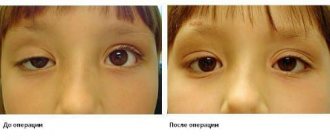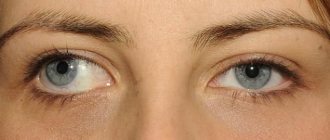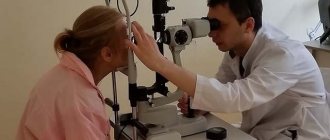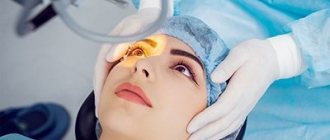Squint surgery is recommended by a doctor if conservative treatment methods do not produce a positive effect. The tactics of surgical intervention are determined individually, based on the degree of deviation of the eyeball and the condition of the muscular system. The effectiveness of surgical intervention reaches 90%.
- 6.1 Video: Strabismus. Is it worth having surgery?
- 7.1 Video: Surgery to correct strabismus in adults. Patient review
Indications for use
Eye surgery to correct abnormalities is not the primary method of treatment. If it was prescribed by a doctor, you should not put it off, since it is impossible to correct the problem in other ways. Due to untreated strabismus, vision is gradually lost.
The purpose of surgery to correct strabismus in children and adults is to eliminate a cosmetic defect and restore binocular vision. Depending on whether there is a deviation in one or both eyes, unilateral or bilateral surgery is performed.
Squint surgery is most often performed in children aged 4-6 years. For children with congenital strabismus, a large deviation angle, and bilateral lesions, surgical intervention is indicated regardless of age.
Strabismus in adults is corrected surgically, taking into account the same indications, as well as at the request of the patient.
When is strabismus in children treated surgically?
This treatment method is used only as a last resort, when conventional therapy has failed. Also, surgery is prescribed at the stage of restoring the functionality of the eye muscles using conservative methods. The procedure is carried out using a laser machine. For very young children it is done under general anesthesia. Schoolchildren are operated on under local anesthesia. During the operation, the surgeon either relaxes the muscle that holds the eye in the wrong position, or strengthens it if it does not hold the eyeball well.
The procedure is painless. The child will be able to leave the hospital the very next day. But he will remain on sick leave for 2-3 weeks. During this period, you will need to regularly visit your doctor and put antibiotic drops in your eyes. This treatment method is rarely prescribed to children. Let's find out whether strabismus can be cured without surgery if the pathology arose in adulthood.
Preparatory stage
Before choosing a surgical method for treating strabismus, the doctor conducts a comprehensive examination of the patient:
- general clinical tests;
- assessment of the functional state of the organ of vision;
- ECG;
- If necessary, consultations with narrow specialists are prescribed.
No special preparation required. If the operation is performed on a child, the last meal should be no later than 12 hours before the operation. This condition is necessary for general anesthesia.
If a pronounced spasm of the extraocular muscles is detected, it is recommended to do special exercises for a month. They allow the muscles to relax and take the most natural position.
Causes of strabismus
The occurrence of strabismus can be due to many reasons:
- farsightedness, myopia or high or moderate astigmatism, as well as a large difference between the visual acuity of the right and left eyes;
- disorders of the development of the extraocular muscles or their attachment;
- pathologies of the central nervous system, paralysis and paresis;
- damage to the organs of vision;
- somatic, infectious diseases;
- mental trauma, etc.
At the Specter clinic, a thorough examination of each patient is performed, which allows us to accurately assess the condition of the eyes and determine the causes of strabismus for individual selection of the most effective treatment methods.
How to perform surgery for strabismus
The surgical method for treating strabismus is selected taking into account the characteristics of the disease. Operations to eliminate strabismus are named according to the technique.
- Recession. The oculomotor muscle is dissected at the site of its attachment and sutured to the sclera. The tension force decreases, the eyeball takes the correct position.
- Myectomy. Dissection of the muscle without subsequent suturing.
- Muscle resection. Due to shortening, the muscle fiber moves the eyeball to its side.
The surgeon uses a laser or radio knife. These devices are the least traumatic and provide instant bleeding stop.
In an adult, surgery is usually performed with local anesthesia. General anesthesia is recommended for strabismus surgery in a child. The adult is allowed to go home a few hours after surgery. In children, the operation takes place in a hospital setting, then they are left under observation for 1-2 days.
Surgery to correct severe strabismus in children takes place in two stages.
- Reducing the angle of strabismus should be done as early as possible. This is done at 12-14 months, when the child is able to tolerate anesthesia.
- The final correction of strabismus is carried out at 4-5 years of age.
In the interval between the stages of surgical correction, conservative treatment is carried out.
The operation will be free if you do it under the compulsory medical insurance policy in a state clinic. If you go to a private hospital, surgery will cost 15,000-30,000 rubles.
Video: Surgical correction of strabismus
Types of surgical treatment of strabismus
The movement of the eyeballs within the orbit is carried out with the help of 6 external extraocular muscles, the synchronous operation of which is controlled by neurons in the brain. Depending on the cause of the disturbance in the focus of the eyeball during strabismus, one of the following surgical techniques can be performed:
- Enhancing surgery (resection) . The length of the muscle shortens. During the operation, part of the muscle segment is excised, the place of its attachment to the eyeball does not change.
- Weakening operation (recession) . The length of the extraocular muscle is increased by transplanting it away from the cornea. As a result of this movement, the muscle relaxes, towards which the focus of the eye is deviated, due to which the eyeball takes an even position.
For strabismus, doctors can also use the following types of surgery:
- Myectomy. The muscle shortens, but no sutures are placed.
- Folding. Folds are added or subtracted to the muscle to correct tension. Such adjustable sutures are applied after the main operation.
- Suturing the muscle to the sclera or tendon. The location of the muscle's attachment changes, causing its action to become stronger or weaker.
Sometimes a combined operation for strabismus is performed, in which surgical intervention is performed on both weak and strong muscles of both eyes. In modern ophthalmology, the technique of adjustable sutures is widely used, the essence of which is to fix the muscles after the main operation using special nodes, with the help of which the position of the extraocular muscles can be corrected in the postoperative period.
In case of paralytic strabismus, rehabilitation of the affected eye muscles can be done using an effective non-surgical technique called chemodenervation of the extraocular muscles. The principle of this type of operation is to inject botulinum toxin into the affected muscle, which helps relax the muscle, thereby causing a decrease in the angle of strabismus.
The type of surgery for strabismus is selected individually by the doctor, taking into account the many nuances of the course of the pathology.
Rehabilitation stage
Immediately after the procedure, swelling and redness of the eye are observed, and pain is possible. This condition lasts 3-5 days, then the symptoms disappear. Full restoration of vision functions lasts about 4 weeks.
After strabismus surgery, you need to perform rehabilitation measures:
- visual gymnastics;
- instillation of vitamin eye drops;
- the use of antihistamines, anti-inflammatory drugs, and analgesics if necessary;
- use of tinted glasses or blindfolds.
Once a week you need to see an ophthalmologist. Postoperative recovery involves limiting physical activity. Patients are advised not to exercise or visit the bathhouse or sauna for a month. The child is exempt from physical education classes at school.
It is recommended to do the exercises daily throughout the year. They help strengthen muscles and prevent recurrence of the disease. If there is a decrease in vision, the baby is given corrective glasses or lenses.
Types of surgeries to correct strabismus
There can be several causes of strabismus, so surgical intervention is selected individually.
There are several types of operations to correct strabismus.
- Recession (weakening) of the extraocular muscle occurs when the muscle is too short. The doctor cuts off the muscle at the attachment point and sews it in another place closer to the original one. This way you can adjust the length of the muscle.
- A partial myotomy is performed when the extraocular muscle is too strong. The doctor cuts out some of the fibers, and the strength of the muscle decreases. There are no stitches.
- The application of posterior fixing sutures is carried out when it is necessary to reduce muscle strength, but preserve the place of their attachment. This operation is also called “Faden”.
- Resection of part of the muscle is performed when the extraocular muscle is too long.
- Formation of a muscle fold is carried out when the muscle is too long. The doctor sews the parts of the muscle together, placing one part on top of the other, like a fold. The muscle becomes shorter and stronger.
Sometimes during surgery, the surgeon combines several actions to achieve optimal position of the eye. The choice of surgery depends on the degree of strabismus or the condition of the extraocular muscles.
Possible complications
Surgical intervention occurs without adverse consequences in most patients. Possible complications:
- injury to the vagus nerve, which leads to disruption of the heart, lungs, and esophagus;
- overcorrection - excessive change in muscle length;
- formation of scars on muscle tissue;
- damage to the eyeball.
Recurrence of the disease during surgical treatment is rare. Strabismus may return if the patient does not carry out rehabilitation measures and ignores visits to the ophthalmologist. Repeated surgery cannot be done within six months after the first.
A rare form of strabismus is Duane's syndrome. With this disease, there is a congenital dysfunction of the oculomotor nerves. The eye is unable to turn towards the temple. Even surgery does not have a positive effect. It is used only to reduce the severity of symptoms.
Video: Strabismus. Is it worth having surgery?
Postoperative period and rehabilitation
Surgical treatment of strabismus gives an immediate visible result - the position of the eyeballs during the visual process becomes correct (symmetrical). However, eliminating a cosmetic problem does not mean complete normalization of visual functions. Since strabismus leads to significant disturbances in the brain processes of visual perception and image analysis, the patient, as a rule, after surgery will undergo a course of exercises and procedures that help restore binocular vision and three-dimensional perception of the surrounding picture of the world. The main task of postoperative rehabilitation after surgical treatment of strabismus is to “teach” the visual system to function correctly again. Most often in modern ophthalmology, hardware treatment is used for these purposes. An individual course of rehabilitation exercises allows you to expand the fusion reserve and re-include the eye in which the movements of the eyeball were impaired in the work of the visual system. The goal of such a course is to achieve an equivalent perception of the pictures formed on the retina of both eyes, and to merge them in the corresponding structures of the brain into a single image.
The ophthalmological clinic offers patients with strabismus a comprehensive examination and multi-stage treatment, including surgery and rehabilitation, individual programs of conservative care, hardware and physiotherapeutic procedures.
Reviews
Patients faced with the need to undergo surgery speak positively about the results.
“My child was diagnosed with strabismus immediately after birth. The severity of the disease was insignificant, so the doctor said that the operation would be possible by the age of 4-5 years. The strabismus disappeared completely after the operation. We did special gymnastics for another year, and now no one can say that the baby had some kind of defect.”
“I have had severe strabismus since childhood. No surgical treatment was carried out at that time; I constantly did gymnastics and synaptophore exercises. There was an improvement, but not much. As an adult, I finally decided to have surgery. The doctor immediately said that it would not be possible to completely correct the defect. The operation was performed, the eye is now squinting just a little.”
In some patients, strabismus can only be corrected through surgery. Surgical treatment can be performed in two ways. It is best to do it in childhood. After the intervention, rehabilitation is carried out - special exercises, vitamin eye drops.
Leave comments and tell us about your experience. Share information with friends on social networks.
How to cure strabismus in adults?
First, let's look at the causes of strabismus that occurs in adulthood. Strabismus in an adult most often appears as a result of:
- cataracts;
- thorn;
- macular degeneration;
- optic nerve atrophy;
- retinal detachment;
- head and eye injuries;
- cranial nerve palsy;
- tumors;
- neuroinfections;
- stroke;
- multiple sclerosis.
The list of factors that can lead to strabismus is quite extensive, so it is incorrect to believe that strabismus is a pathology that manifests itself exclusively in childhood.
Often in adults, strabismus is a concomitant disease. Most of the main ailments are treated with surgical methods.











